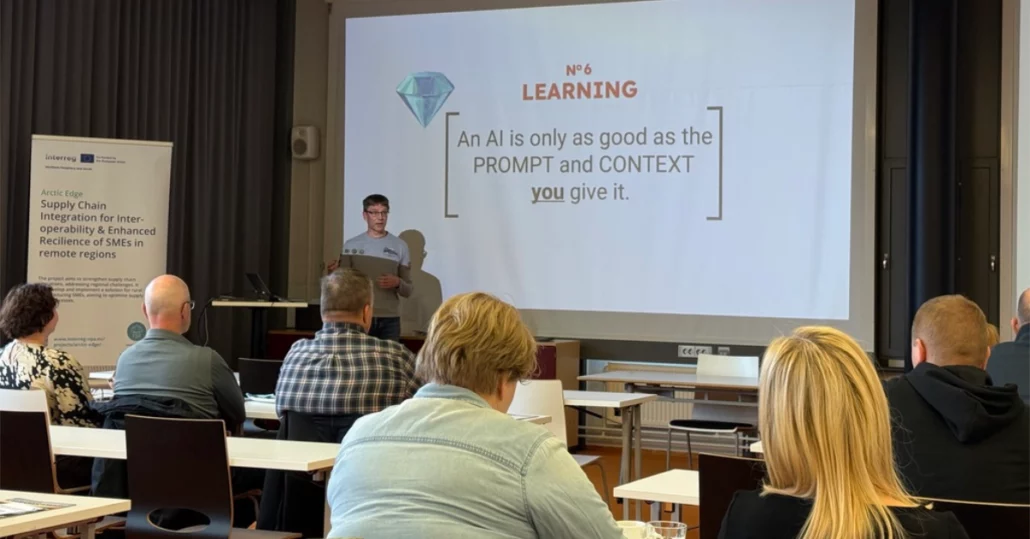What I heard (and didn’t hear) in AI workshops
When was the last time your boss said, “You don’t have to hit every target this quarter. Use three hours a week to learn something new.” I can’t remember that ever happening, and neither can most of the people who show up in my AI workshops. Participants are curious, motivated and even excited, but they are also under pressure. They’re told to learn generative AI on top of everything else they already do. That’s not how real transformation happens.
In my first post on this topic, I argued that AI projects fail more because of people, data and leadership than because of code. An international survey backs that up: only about one‑third of workers say they have been properly trained to use AI. Worse, more than half of frontline employees say they would use unauthorised AI tools when approved solutions fall short. Adoption is high (72% of workers use AI regularly) but has stalled for frontline employees. Meanwhile, just a quarter of them feel they have enough guidance from their leaders. We are asking people to change how they work without giving them the time, clarity or support to do so.
The real issue isn’t AI adoption, it’s support
BCG’s AI at Work 2025 study reveals a few uncomfortable truths:
- Training matters. Only 36% of employees feel properly trained to use AI. Those who receive more than five hours of instruction are far more likely to become regular users than those with less training. In fact, employees with in‑person training and coaching report 79% regular usage versus 67% among those with less than five hours.
- Shadow AI is growing. When corporate tools don’t meet their needs, 54% of respondents say they would turn to unauthorised tools. Gen Z and millennials are especially likely to bypass restrictions, a sign that policies alone won’t stop risky behaviour.
- Leadership support is rare. Only one in four frontline workers say their leaders provide enough guidance on how and when to use AI. Yet in teams with strong leadership support, 82% of employees become regular users, compared with 41% where support is weak.
- Time saved isn’t the only benefit. At Novo Nordisk, a global rollout of Microsoft Copilot saved employees an average of 2.17 hours per week, but satisfaction was driven more by improved quality of work than raw efficiency. People reinvested the time they saved into strategic planning, creative work and conversations with colleagues. This aligns with my own experience: developers who learn to automate routine tasks often use the extra hours to design better APIs or mentor junior colleagues.
These data points reinforce what I’ve seen in Finland and abroad. People aren’t resistant; they are busy, uncertain and often unsupported. Enthusiasm alone isn’t enough to drive adoption. We need to free up hours and create the conditions for learning.
What works: four practical shifts
1. Make learning part of the job
In my workshops, I ask participants how many hours their employer sets aside for AI training. The answer is usually zero. That’s tragic. BCG’s study shows that regular AI usage doubles when employees receive at least five hours of structured training. Block out time (three to five hours a week) for experimentation and practice. Treat it as billable time, not a hobby. You’ll quickly recover those hours when teams start automating meeting notes, test data generation or customer‑email drafts.
2. Lead with permission, not pressure
Executives often tell employees to “use AI more” without showing when or how. My suggestion: flip the script. Give your team permission to slow down, experiment and fail. Build this into goals and appraisals. In Novo Nordisk’s rollout, leadership framed AI as a tool to make time the ultimate currency. That message signalled that saving time and improving quality mattered more than blindly hitting deadlines. When employees know they won’t be punished for taking time to learn, adoption accelerates.
3. Turn curiosity into community
Every company has early adopters who tinker with new tools. Formalising them as AI champions can unlock peer influence. Research from Wharton notes that formal or informal “AI champions” within teams can share practical tips and reduce stigma around using AI. Peer support can be more powerful than top‑down mandates. Establish small champion groups or buddy systems where those who have integrated AI into their work coach others. This approach not only normalises everyday usage but also surfaces real use cases faster than any policy document.
4. Reduce noise, increase context
Most employees are drowning in tools and buzzwords. The BCG survey lists lack of skills, inadequate tools and poor leadership support as the top three barriers to adoption. Focus on a handful of clear use cases that save time or improve quality. For example:
- Summarise customer conversations to extract action items.
- Generate draft documentation for common functions and APIs.
- Classify support tickets to prioritise responses.
Start with a single department or dataset, demonstrate value and then scale. Remember that less is more: one well‑designed workflow beats ten pilots that go nowhere.
A framework for sustainable AI adoption
Bringing AI into an organisation isn’t just about deploying a chatbot. It’s about redesigning work so that people and machines complement each other. Based on my experiences and the data cited above, here’s a simple framework:
- Schedule learning. Allocate at least three hours per week for teams to experiment with AI tools. Combine self‑paced tutorials with in‑person workshops and coaching. As BCG’s research shows, five hours of training plus coaching significantly boosts adoption.
- Connect the dots. Make one “safe” dataset accessible through an approved tool. Start with anonymised support tickets or product manuals. As teams see value, gradually open more datasets. This reduces the temptation to feed confidential data into external models.
- Clarify governance. Publish a living AI policy that spells out what data can be used, which tools are approved and how to request new tools. Address the risk of shadow AI head‑on. Without clear guidance, younger workers are far more likely to bypass restrictions.
- Build champion networks. Identify natural influencers (developers, analysts or customer‑service reps) and support them as coaches. Peer mentoring lowers barriers and helps normalise usage. Celebrate small wins to encourage momentum.
- Measure and share impact. Track time saved, quality improvements and employee satisfaction. Novo Nordisk found that quality improvements mattered more to employees than raw efficiency. Share stories of success and failure. Data without storytelling rarely drives change.
Closing thoughts
AI doesn’t grow through hype; it grows through practice, permission and patience. Give your teams the time to learn, the safety to experiment and the community to share insights. Only then will generative AI move from a buzzword to a daily habit.


